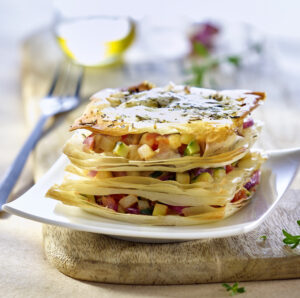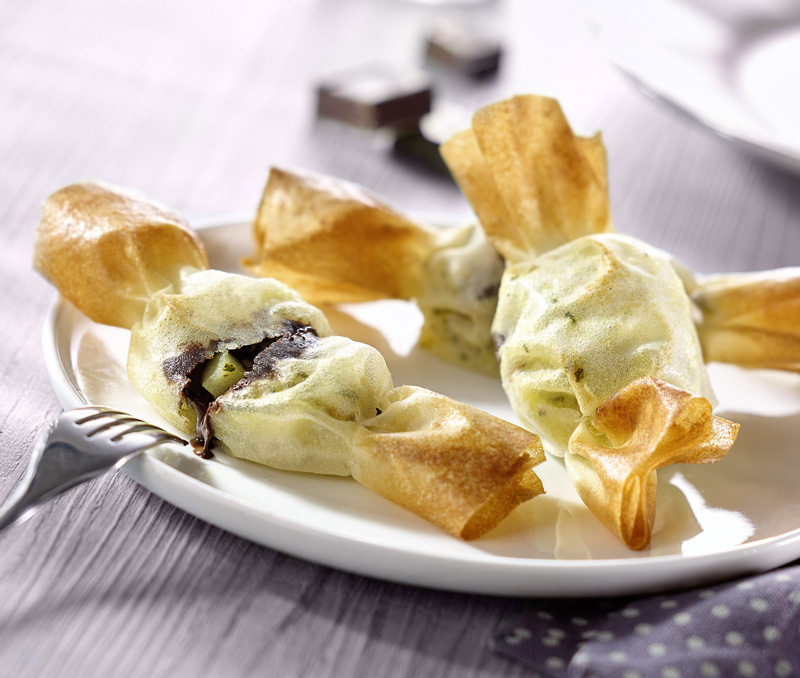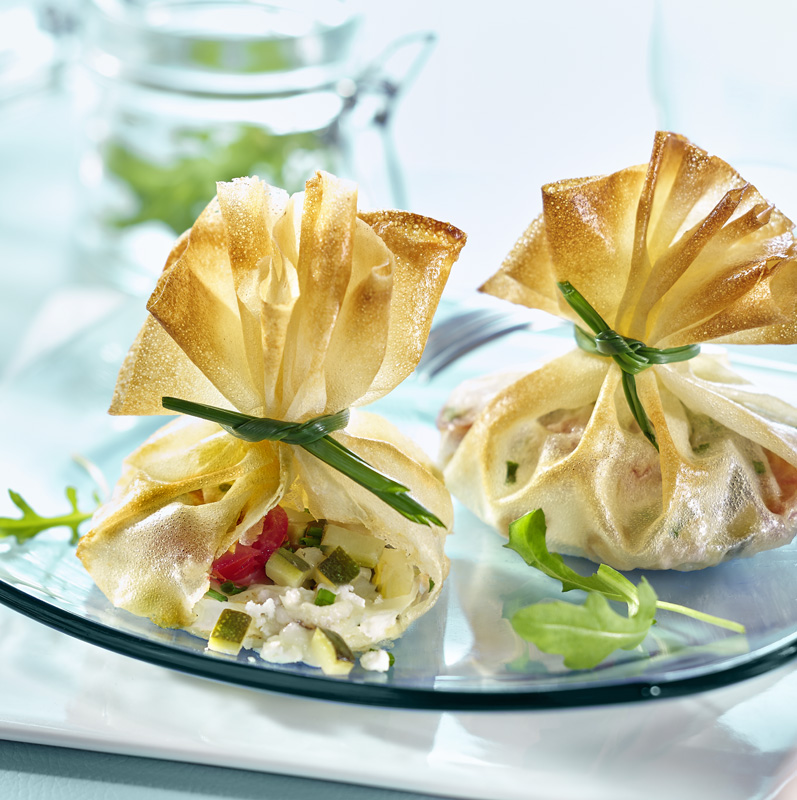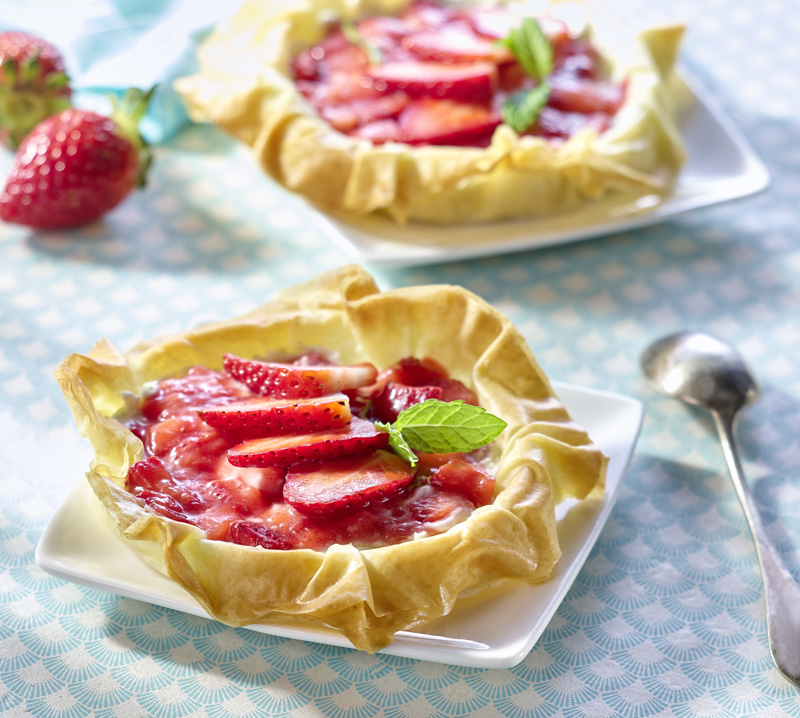Filo pastry is a very thin puff pastry product that has been an essential component in various cultures throughout history. The dish has its roots in the Middle East, especially in the time of the Ottoman Empire, around the 15th century. The master pastry chefs of the time were the pioneers in the creation and development of this thin and delicate pastry.
The name comes from the word ‘filo’, which means ‘leaf’, representing the thinness of the dough. To obtain this characteristic shape, the dough is stretched into extremely thin sheets, which in turn gives it its characteristic crunchy texture.
What is filo pastry?
Filo pastry is a product that uses flour, water, salt and, in some cases, oil, to obtain a soft dough. Unlike other doughs, it does not contain yeast, which contributes to its light and crunchy texture. This delicious dough comes in sheets that allow for thin, perfectly separated layers when baked.
Its versatility has taken it to many kitchens around the world. Today, it has evolved to take on different forms of preparation in international gastronomy. Filo pastry has transcended its Ottoman roots to become a prized ingredient to enhance a variety of dishes.

Types of filo pastry
There are different variations of filo pastry to suit different culinary preferences and dietary needs. Here are some of the most common types:
- Traditional filo pastry. This is the classic way of preparing it, made with flour, water, salt and, in some cases, a small amount of oil. It is known for its extreme thinness and crispness.

- With butter. In addition to its traditional ingredients, this type of dough incorporates butter between the layers of dough during the rolling process. This gives it a richer flavour and a softer, more delicate texture when baked.
- Wholemeal filo pastry. To include this product in a healthy diet, there is a wholemeal version of filo pastry. This is made from wholemeal flour, offering a nutritional profile richer in fibre and nutrients.
- Gluten-free. For people with gluten sensitivity or coeliac disease, there are also gluten-free filo pastry options. These are made with alternative flours such as rice flour, almond flour or corn flour.
- Spiced filo pastry. In this version, the only difference to traditional filo pastry is that it is enriched with spices such as cinnamon, nutmeg or cardamom. This type of flavoured filo pastry adds a distinctive touch to both sweet and savoury dishes.
- Ready-made filo pastry. For convenience, pre-packaged, ready-to-use filo pastry sheets are available on the market. These are usually frozen and only need to be thawed before use, making it easy to prepare quick and convenient dishes.

Health benefits
Filo pastry is low in saturated fat and contains no cholesterol. Compared to some denser doughs, filo pastry has certain aspects that can be considered nutritionally beneficial.
Low in saturated fat
Thanks to its ingredients, it is low in saturated fat, which is good for cardiovascular health. Although some of its variants incorporate butter or oil between the layers, the amount used is usually less compared to other doughs.
No cholesterol
As it contains no animal ingredients such as eggs or dairy products, it is naturally cholesterol-free. This makes it a healthier option for those looking to reduce their cholesterol intake but still enjoy a sweet product.
Rich in protein and fibre
Filo pastry includes proteins for building and repairing tissues in the body. These are essential for muscles, bones, skin or hair, among others.
In addition, it contains fibre, an essential nutrient that plays a key role in maintaining the health and optimal functioning of the human body. It also helps prevent or relieve constipation by facilitating its passage through the digestive system.

In which dishes can filo pastry be used?
The versatility of filo pastry makes it a very useful product for creating a wide variety of sweet or savoury dishes. Here are some clever ideas to combine in your kitchen:
- Spanakopita. A classic Greek dish combining spinach, feta cheese and herbs wrapped in layers of filo pastry.
- Samosas. These are traditional Indian pasties, with fillings including potatoes, peas, spices and meat, all wrapped in sheets of filo pastry.
- Spring rolls. This product can be used in Asian spring rolls filled with vegetables, meat and rice noodles.
- Canapés and appetizers. If cut into small pieces and baked or fried, it can be used as a base for canapés and appetizers.
- Baklava. This is a traditional Middle Eastern dessert consisting of layers of filo pastry sandwiched with walnuts or almonds and dipped in honey syrup.
- Cinnamon rolls. Another sweet dessert is cinnamon rolls, which are made from crispy sheets of pastry filled with cinnamon and sugar.
- Apple strudel. A European dessert in which apples, cinnamon and walnuts are wrapped in layers of filo pastry and baked to a delicious crunchy mixture.
Premium brands
JR, a French company dedicated to the production of refrigerated filo pastry of the highest quality. It manufactures products that are easy to use and developed in a traditional way. An original alternative to classic pastry cooking.
KANAKI has been the market leader in frozen filo pastry in Greece for 40 years. It stands out for its high quality, high nutritional value and the great taste of its products. The love for tradition and gastronomy distinguishes KANAKI, which through its products offers delicious flavours with healthy ingredients inspired by Greek and Mediterranean cuisine.


